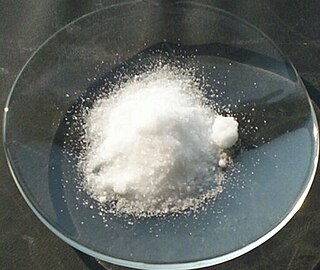Related Research Articles

Tobacco is the common name of several plants in the genus Nicotiana of the family Solanaceae, and the general term for any product prepared from the cured leaves of these plants. More than 70 species of tobacco are known, but the chief commercial crop is N. tabacum. The more potent variant N. rustica is also used in some countries.

Potassium nitrate is a chemical compound with a sharp, salty, bitter taste and the chemical formula KNO
3. It is an ionic salt of potassium ions K+ and nitrate ions NO3−, and is therefore an alkali metal nitrate. It occurs in nature as a mineral, niter (or nitre outside the US). It is a source of nitrogen, and nitrogen was named after niter. Potassium nitrate is one of several nitrogen-containing compounds collectively referred to as saltpeter (or saltpetre outside the US).

Toothpaste is a paste or gel dentifrice used with a toothbrush to clean and maintain the aesthetics and health of teeth. Toothpaste is used to promote oral hygiene: it is an abrasive that aids in removing dental plaque and food from the teeth, assists in suppressing halitosis, and delivers active ingredients to help prevent tooth decay and gum disease (gingivitis). Owing to differences in composition and fluoride content, not all toothpastes are equally effective in maintaining oral health. The decline of tooth decay during the 20th century has been attributed to the introduction and regular use of fluoride-containing toothpastes worldwide. Large amounts of swallowed toothpaste can be poisonous. Common colors for toothpaste include white and blue.

The Colgate-Palmolive Company, commonly known as Colgate-Palmolive, is an American multinational consumer products company headquartered on Park Avenue in Midtown Manhattan, New York City. The company specializes in the production, distribution, and provision of household, health care, personal care, and veterinary products.

Snus is a Swedish tobacco product and non-tobacco nicotine product consumed by placing a pouch of powdered tobacco leaves or powdered non-tobacco plant fibers under the lip for nicotine to be absorbed through the oral mucosa. Whereas the nicotine in tobacco-based snus derives from tobacco leaves, the nicotine in non-tobacco snus can be either naturally or synthetically synthesized.
Crest is an American brand of toothpaste and other oral hygiene products made by American multinational Procter & Gamble (P&G) and sold worldwide. In many countries in Europe, such as Germany, Bulgaria, Serbia, Ukraine, Belarus, Russia, Poland, Hungary, Latvia, Romania, Estonia and Lithuania, it is sold as Blend-A-Med, the name of an established German toothpaste acquired by P&G in 1987. In France, Spain, Italy, Israel, Sweden, Finland, Colombia, Belgium, the Netherlands, Brazil, the United Kingdom, the Republic of Ireland, Australia, Nigeria, Greece, Uruguay and Argentina, P&G markets similar toothpaste formulations under the Oral-B brand.
A humectant is a hygroscopic (water-absorbing) substance used to keep things moist. They are used in many products, including food, cosmetics, medicines and pesticides. When used as a food additive, a humectant has the effect of keeping moisture in the food. Humectants are sometimes used as a component of antistatic coatings for plastics.

Cohoba is a Taíno transliteration for a ceremony in which the ground seeds of the cojóbana tree were inhaled, the Y-shaped nasal snuff tube used to inhale the substance, and the psychoactive drug that was inhaled. Use of this substance produced a hallucinogenic, entheogenic, or psychedelic effect. The cojóbana tree is believed by some to be Anadenanthera peregrina although it may have been a generalized term for psychotropics, including the quite toxic Datura and related genera (Solanaceae). The corresponding ceremony using cohoba-laced tobacco is transliterated as cojibá. This was said to have produced the sense of a visionary journey of the kind associated with the practice of shamanism.

In organic chemistry, nitrosamines are organic compounds with the chemical structure R2N−N=O, where R is usually an alkyl group. They feature a nitroso group bonded to a deprotonated amine. Most nitrosamines are carcinogenic in nonhuman animals. A 2006 systematic review supports a "positive association between nitrite and nitrosamine intake and gastric cancer, between meat and processed meat intake and gastric cancer and oesophageal cancer, and between preserved fish, vegetable and smoked food intake and gastric cancer, but is not conclusive".

Wintergreen is a group of aromatic plants. The term wintergreen once commonly referred to plants that remain green throughout the winter. The term evergreen is now more commonly used for this characteristic.

Dipping tobacco is a type of finely ground or shredded, moistened smokeless tobacco product. It is commonly and idiomatically known as dip. Dipping tobacco is used by placing a pinch, or "dip", of tobacco between the lip and the gum. The act of using it is called dipping. Dipping tobacco is colloquially called chaw, snuff, rub, or fresh leaf among other terms; because of this, it is sometimes confused with other tobacco products—namely dry snuff.

U.S. Smokeless Tobacco Company is an American company that manufactures smokeless tobacco products, notably dipping tobacco, as well as chewing tobacco, snus, and dry snuff. The company is a subsidiary of Altria.
Kodiak is a brand of dipping tobacco manufactured by American Snuff Company, a U.S. smokeless tobacco manufacturer which also produces the Grizzly tobacco and Levi Garrett brands. Introduced in 1980, Kodiak is currently available in three flavors: Wintergreen, Mint , and Straight, each featuring a picture of a Kodiak bear on the top label. Kodiak recently introduced pouches, which hold the moist snuff in a tea-bag like pouch, preventing it from spreading around the mouth and keeping it out of the teeth.

Snuff is a type of smokeless tobacco product made from finely ground or pulverized tobacco leaves. It is snorted or "sniffed" into the nasal cavity, delivering nicotine and a flavored scent to the user. Traditionally, it is sniffed or inhaled lightly after a pinch of snuff is either placed onto the back surface of the hand, held pinched between thumb and index finger, or held by a specially made "snuffing" device.
Herbal smokeless tobacco is any product that imitates types of smokeless tobacco but does not contain tobacco and nicotine, or may contain nicotine without tobacco. Like herbal cigarettes and electronic cigarettes, they are often used as a tobacco cessation aid. Herbal smokeless tobacco use is an alternative to using smokeless tobacco that may help users quit.
Snuff may refer to:
Smokeless tobacco keratosis (STK) is a condition which develops on the oral mucosa in response to smokeless tobacco use. Generally it appears as a white patch, located at the point where the tobacco is held in the mouth. The condition usually disappears once the tobacco habit is stopped. It is associated with slightly increased risk of mouth cancer.
References
- ↑ Sivaramakrishnan, V.M. (2001). Tobacco and Areca Nut. Orient Blackswan. p. 17. ISBN 978-81-250-2013-4 . Retrieved 2008-11-08.
- ↑ Smokeless Tobacco Or Health. DIANE Publishing. 1993. p. 62. ISBN 978-0-7881-2067-1 . Retrieved 2008-11-08.